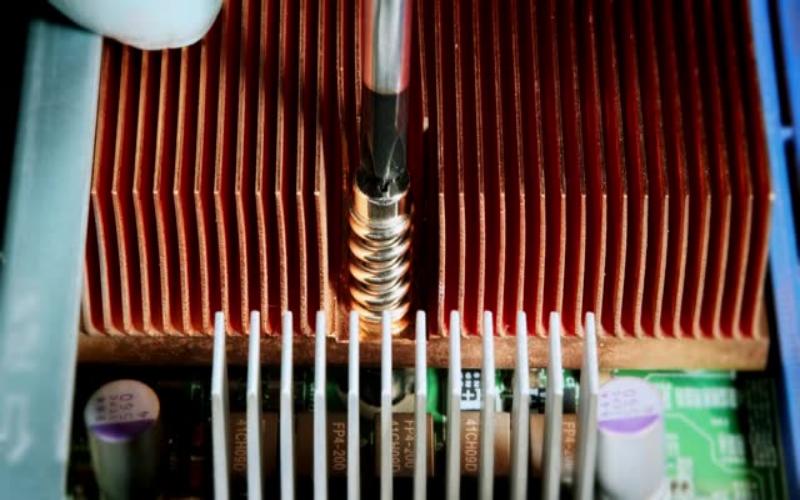The Essential Guide to Understanding Computer Heat Sinks
Introduction:
When it comes to the performance and longevity of your computer, heat management is a crucial factor to consider. Overheating can lead to various issues, including decreased performance, hardware failure, and even permanent damage. One of the key components responsible for dissipating heat in a computer is the heat sink. In this article, we will explore what computer heat sinks are made of and how they help keep your system cool.
1. The Role of Heat Sinks in Computers
A heat sink is a passive cooling device that helps transfer heat away from the central processing unit (CPU) or other heat-generating components in a computer. Its primary function is to absorb and dissipate the excess heat generated by these components, preventing them from reaching critical temperatures.
2. Aluminum Heat Sinks: Lightweight and Efficient
One of the most commonly used materials for computer heat sinks is aluminum. Aluminum heat sinks offer several advantages, including their lightweight nature, excellent thermal conductivity, and affordability. The lightweight property of aluminum makes it ideal for portable devices, as it does not add significant weight to the overall system.
3. Copper Heat Sinks: Superior Thermal Conductivity
Copper is another popular material for heat sinks due to its exceptional thermal conductivity. Compared to aluminum, copper has a higher thermal conductivity, meaning it can transfer heat more efficiently. This makes copper heat sinks particularly effective in high-performance systems where heat dissipation is crucial.
4. Combination Heat Sinks: The Best of Both Worlds
In some cases, heat sinks may be made from a combination of materials, such as aluminum and copper. These hybrid heat sinks leverage the benefits of both materials. The base of the heat sink may be made of copper, which offers superior thermal conductivity, while the fins are made of aluminum to provide lightweight and cost-effective cooling.
5. Pure Copper Heat Pipes: Efficient Heat Transfer
Heat pipes are another important component often used in conjunction with heat sinks. A heat pipe is a sealed copper tube that contains a small amount of liquid, typically water or a specialized coolant. When heat is applied to one end of the pipe, the liquid absorbs the heat and vaporizes, carrying the heat away to the other end where it condenses and releases the heat. Heat pipes combined with copper heat sinks provide an efficient method of heat transfer.
6. Vapor Chamber Heat Sinks: Advanced Cooling Solutions
Vapor chamber heat sinks are an advanced cooling solution that utilizes the principles of heat pipes on a larger scale. They consist of a flat plate filled with a small amount of liquid that vaporizes and condenses, transferring heat away from the source. Vapor chambers offer superior heat conductivity and distribution, making them highly efficient in dissipating heat from powerful CPUs and GPUs.
7. Graphite Heat Sinks: Lightweight and Innovative
Graphite heat sinks are a relatively new development in heat sink technology. Graphite is an excellent conductor of heat and has a lightweight nature, making it an ideal material for heat sinks. Graphite heat sinks offer comparable performance to copper heat sinks but with the added advantage of being significantly lighter.
8. Heat Sink Manufacturing Processes
Heat sinks can be manufactured using various processes, including extrusion, casting, and forging. Extrusion is the most common method, where a heated aluminum or copper billet is forced through a die to create the desired shape. Casting involves pouring molten metal into a mold, while forging involves shaping the metal through controlled deformation.
9. Additional Factors in Heat Sink Design
Aside from the materials used, several other factors play a role in heat sink design. These include the surface area of the heat sink, the number and design of fins, the presence of heat pipes or vapor chambers, and the overall placement and airflow within the computer case. All these factors contribute to optimizing heat dissipation and ensuring the efficient cooling of the system.
10. Conclusion: Choosing the Right Heat Sink
When it comes to selecting a heat sink for your computer, it is essential to consider the specific needs of your system. Factors such as the power requirements, size constraints, and thermal demands of your components should influence your decision. Whether you opt for an aluminum heat sink for its lightweight nature, a copper heat sink for its superior thermal conductivity, or a combination heat sink for the best of both worlds, ensuring proper cooling is vital for the optimal performance and longevity of your computer.

